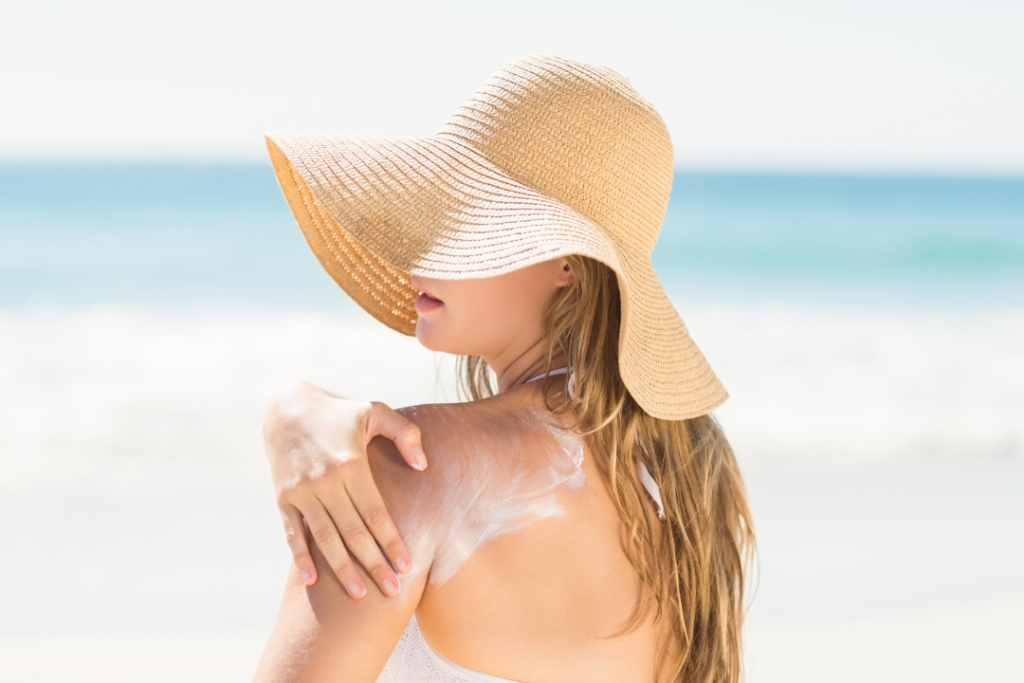Dihydroxyacetone (DHA) is an ingredient in many self-tanning lotions. While effective, it also comes with risks and side effects. Fortunately, some brands offer sugar beet-derived DHA as a safer alternative to traditional DHA in tanning lotion. Read on to discover how you can get that enviable glow without the risks.
From pale-faced to sun-kissed
Before the early twentieth century, tanned skin was viewed as a sign of poverty or being of the “working class” by many cultures worldwide. Caucasian women in western culture, especially those of the upper class, avoided the sun and even used makeup to achieve an ivory skin tone. Then in 1923, that attitude changed when, upon her return from vacationing in Cannes, French designer Coco Chanel was photographed with a “sun-kissed” look – that she didn’t intend to get! As the most popular fashion influencer of her time, her fans followed her style and sought the same healthy-looking bronze glow.
It’s been 100 years since Coco got her tan, and we’ve learned much about suntanning. Decades of excessive sunbathing, sunlamps, and tanning beds have been linked to an increase in skin cancer and prematurely aging skin.
The advent of self-tanners has made it possible for you to get color without laying in the sun for hours and putting yourself at risk for skin cancer. But even this safer option must be investigated to help you make the best and safest product choice.
Sugar Beet-Derived DHA in Tanning Lotion: Self-Tanning Without the Risks is an original (Skin&BeautyJournaly) article.
DHA in tanning lotion – what it is and how it works
Dihydroxyacetone (DHA) is a colorless sugar commonly used as a self-tanning agent in cosmetic products. Within two to six hours of application, DHA reacts with the amino acids in the dead cells of the stratum corneum (the outer layer of human skin) to produce melanoidins, which are responsible for creating a brownish color on the skin. This chemical process is known as the Maillard reaction, a term used in cooking when referring to browning food to give it flavor, such as searing a steak or caramelizing onions.
Essentially, your skin is being chemically baked – just enough to give it a golden brown color and without the risk of ultraviolet damage that can come with suntanning. Your tan will fade three to seven days after application due to regular skin exfoliation (shedding), just as a traditional suntan would.
DHA in tanning lotion – how safe is it?
DHA is the only substance approved for topical application by the Food and Drug Administration (FDA). It’s defined as a color additive for your body. The FDA has strict specifications that companies based in the United States must adhere to when formulating their self-tanning products.
Because of the lack of safety data, the FDA has not approved the use of DHA in spray-on tanning booths. The concern is that all-over sprays might be inhaled or come in contact with lips, eyes, or mucous membranes, which may increase the risk of developing chronic obstructive pulmonary disease (COPD), asthma, or cancer. These concerns don’t include self-applied products like mousse, lotions, or wipes. The Canadian Health Ministry and many EU (European Union) member nations also approved DHA for use in self-tanners.
While most people don’t experience adverse side effects when using self-tanning products containing DHA, some potential risks are associated with its use. These range from minor skin irritations to more severe cases of contact dermatitis or allergic reactions. A severe reaction is extremely rare, with as few as two people in every 100,000 being affected with allergies due to DHA in tanning lotion. Most reactions to suntan products are caused by other ingredients such as parabens, alcohol (Ethanol), fillers, and artificial fragrances. Using products with more natural ingredients and conducting a patch test on your body to ensure that you’re not allergic can help avoid painful skin irritation.

Synthetic vs. natural DHA in tanning lotion
DHA is obtained from the compound glycerol (also called glycerin). Synthetic DHA is a laboratory-created version of the naturally-occurring DHA found in sugar beets and other plants; it’s produced by a chemical process to obtain a high-purity DHA product. The process can vary depending on the manufacturer. Synthetic processing is faster and more cost-effective than natural fermentation or direct oxidation of glycerol.
Natural DHA is plant-based and obtained by bioconversion of the glycerol found in certain plants – with sugar beets being one of the most-used plant sources. The typical method to convert glycerol to usable DHA is microbial fermentation which starts with extracting the sugars from the plant material, typically through juicing or crushing. The extracted juice is fermented using microorganisms such as bacteria, yeast, fungi, or enzymes to convert the raw materials into gluconic acid, which is further processed to obtain DHA. Natural processing takes longer, produces lower yields, and is more costly than synthetic methods.
Synthetic and natural DHA are both considered safe for skin use and equally effective in providing a sunless tan. However, naturally processed DHA is favored by people who want to avoid the additional chemicals used in synthetic processing, and it’s considered a more sustainable and environmentally-friendly alternative to traditional chemical-based production methods.

Things to consider when choosing a self-tanning product
In addition to choosing a product containing naturally derived DHA, it’s also important to read the ingredient list and check that the product is free from unnatural ingredients like:
- Parabens
- Propylene Glycol
- Formaldehyde
- Ethanol (another name for alcohol)
- Alcohol
- Artificial perfumes
- Mineral oil
- Artificial preservatives
Sugar beet-derived DHA in tanning lotion – a sweet way to a safer self-tan
Beauty by Earth, based in Texas, specializes in affordable natural beauty products. They have an extensive line of plant-based self-tanners for your face and body formulated without harsh chemicals. These tanners also use DHA, which is naturally derived from sugar beets. Furthermore, their products contain natural vegan ingredients that nourish the skin. Beauty By Earth self-tanners come in various forms, including lotions, serums, drops, mousse, and body sprays.
Founder Prudence Millsap is all about educating the consumer. She believes that “since Covid, people are looking more closely at ingredient lists and are seeking clean and trustworthy products.” With assistance from a cosmetic chemist, Prudence determines exactly what goes into her product line. Additionally, she listens to her customers and believes in giving them what they want. She refuses to cut costs by using synthetically derived DHA and yet manages to keep her products affordable for the average consumer.
All Beauty By Earth Products come with a 100% satisfaction guarantee and a hassle-free 30-day guarantee for all purchases. No questions asked.

DHA in tanning lotion can safely give you the glow you’re looking for
If you purchase a self-tanner containing sugar beet-derived DHA, you’ll feel more confident in your tanning product and may reduce your risk of adverse skin reactions. Additionally, natural products are typically formulated with other beneficial ingredients to keep your skin healthy. While natural self-tanner is not a substitute for sunscreen or sun protection, it prevents you from being subjected to the sun’s harmful rays while still providing a tan that looks and feels organic.
For further reading:
Elle – “A Brief History Of Tanning Throughout The Ages”
Scientific American – “How do sunless tanners work?”
FDA – “Sunless Tanners & Bronzers”
National Center for Biotechnology Information – “A Review of Common Tanning Methods”
DermNet – “Dihydroxyacetone, tanning cream, sunless tanning”
National Center for Biotechnology Information – “Dihydroxyacetone: An Updated Insight into an Important Bioproduct”
Environmental Working Group – “What Are Parabens, and Why Don’t They Belong in Cosmetics?”
Important Note: The information contained in this article (Sugar Beet-Derived DHA in Tanning Lotion: Self-Tanning Without the Risks) is for general informational purposes only, and should not be construed as health or medical advice, nor is it intended to diagnose, prevent, treat, or cure any disease or health condition. Before embarking on any diet, fitness regimen, or program of nutritional supplementation, it is advisable to consult your healthcare professional in order to determine its safety and probable efficacy in terms of your individual state of health.
Regarding Nutritional Supplements Or Other Non-Prescription Health Products: If any nutritional supplements or other non-prescription health products are mentioned in the foregoing article, any claims or statements made about them have not been evaluated by the U.S. Food and Drug Administration, and such nutritional supplements or other health products are not intended to diagnose, treat, cure, or prevent any disease.